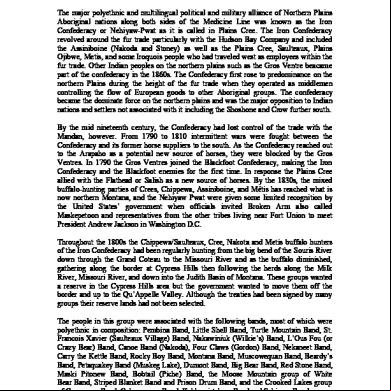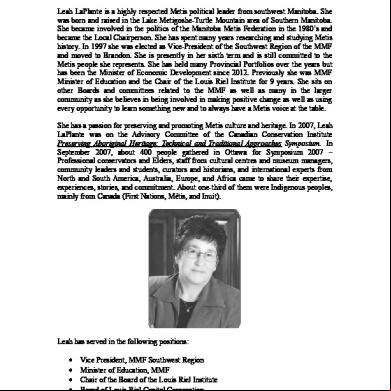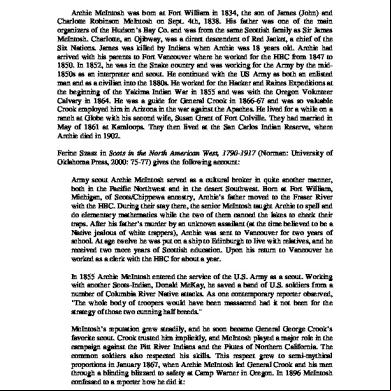Iron Confederacy (nehiyaw Pwat) 6639e
This document was ed by and they confirmed that they have the permission to share it. If you are author or own the copyright of this book, please report to us by using this report form. Report 445h4w
Overview 1s532p
& View Iron Confederacy (nehiyaw Pwat) as PDF for free.
More details 6h715l
- Words: 741
- Pages: 2
The Iron Confederacy, The Nehiyaw Pwat The major polyethnic and multilingual political and military alliance of Northern Plains Aboriginal nations along both sides of the Medicine Line was known as the Iron Confederacy or Nehiyaw-Pwat as it is called in Plains Cree. The Iron Confederacy revolved around the fur trade particularly with the Hudson Bay Company and included the Assiniboine (Nakoda and Stoney) as well as the Plains Cree, Saulteaux, Plains Ojibwe, Metis, and some Iroquois people who had traveled west as employees within the fur trade. Other Indian peoples on the northern plains such as the Gros Ventre beacame part of the confederacy in the 1860s. The Confederacy first rose to predominance on the northern Plains during the height of the fur trade when they operated as middlemen controlling the flow of European goods to other Aboriginal groups. The confederacy became the dominate force on the northern plains and was the major opposition to Indian nations and settlers not associated with it including the Shoshone and Crow further south. By the mid nineteenth century, the Confederacy had lost control of the trade with the Mandan, however. From 1790 to 1810 intermittent wars were fought between the Confederacy and its former horse suppliers to the south. As the Confederacy reached out to the Arapaho as a potential new source of horses, they were blocked by the Gros Ventres. In 1790 the Gros Ventres ed the Blackfoot Confederacy, making the Iron Confederacy and the Blackfoot enemies for the first time. In response the Plains Cree allied with the Flathead or Salish as a new source of horses. By the 1830s, the mixed buffalo-hunting parties of Crees, Chippewa, Assiniboine, and Métis has reached what is now northern Montana, and the Nehiyaw Pwat were given some limited recognition by the United States’ government when officials invited Broken Arm also called Maskepetoon and representatives from the other tribes living near Fort Union to meet President Andrew Jackson in Washington D.C. Throughout the 1800s the Chippewa/Saulteaux, Cree, Nakota and Metis buffalo hunters of the Iron Confederacy had been regularly hunting from the big bend of the Souris River down through the Grand Coteau to the Missouri River and as the buffalo diminished, gathering along the border at Cypress Hills then following the herds along the Milk River, Missouri River, and down into the Judith Basin of Montana. These groups wanted a reserve in the Cypress Hills area but the government wanted to move them off the border and up to the Qu’Appelle Valley. Although the treaties had been signed by many groups their reserve lands had not been selected. The people in this group were associated with the following bands, most of which were polyethnic in composition: Pembina Band, Little Shell Band, Turtle Mountain Band, St. Francois Xavier (Saulteaux Village) Band, Nakawiniuk (Wilkie’s) Band, L’Ous Fou (or Crazy Bear) Band, Canoe Band (Nakoda), Four Claws (Gordon) Band, Nekaneet Band, Carry the Kettle Band, Rocky Boy Band, Montana Band, Muscowequan Band, Beardy’s Band, Petaquakey Band (Muskeg Lake), Dumont Band, Big Bear Band, Red Stone Band, Maski Pitonew Band, Bobtail (Piche) Band, the Moose Mountain group of White Bear Band, Striped Blanket Band and Prison Drum Band, and the Crooked Lakes group of Cowessess Band, Ochapowace Band, Kahkewistahow Band and Sakimay Band.
1
In 1878, the Half-Breeds and others of the Confederacy living in the vicinity of Cypress Hills petitioned the government for their own reserve. This is a petition requested a reopening of the buffalo hunt between November 14th and February15th each year and the granting of Metis “reserve” land. The request was for a strip of land 150 miles long along the American border beginning where the Pembina River crosses the border, running west for 150 miles into Saskatchewan. This strip was to be fifty miles from south to north. The petition did not receive a favourable response. This meeting and petition was one of the last great assemblies of the Nehiyaw Pwat. The eventual decline of the fur trade and the deliberate eradication of the bison herds by Canadian and American hunters, and lack of response to political requests such as the 1878 petition led to the defeat and breaking of the confederacy which subsequently saw defeat in military action against Canada during the 1885 Northwest Resistance referred to by the Cree as ê-mâyihkamikahk, which means “when it went wrong.”
Compiled by Lawrence Barkwell Coordinator of Metis Heritage and History Research Louis Riel Institute
2
1
In 1878, the Half-Breeds and others of the Confederacy living in the vicinity of Cypress Hills petitioned the government for their own reserve. This is a petition requested a reopening of the buffalo hunt between November 14th and February15th each year and the granting of Metis “reserve” land. The request was for a strip of land 150 miles long along the American border beginning where the Pembina River crosses the border, running west for 150 miles into Saskatchewan. This strip was to be fifty miles from south to north. The petition did not receive a favourable response. This meeting and petition was one of the last great assemblies of the Nehiyaw Pwat. The eventual decline of the fur trade and the deliberate eradication of the bison herds by Canadian and American hunters, and lack of response to political requests such as the 1878 petition led to the defeat and breaking of the confederacy which subsequently saw defeat in military action against Canada during the 1885 Northwest Resistance referred to by the Cree as ê-mâyihkamikahk, which means “when it went wrong.”
Compiled by Lawrence Barkwell Coordinator of Metis Heritage and History Research Louis Riel Institute
2










